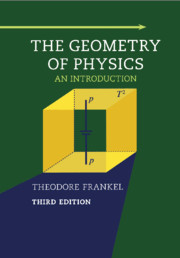Book contents
- Frontmatter
- Contents
- Preface to the Third Edition
- Preface to the Second Edition
- Preface to the Revised Printing
- Preface to the First Edition
- Overview. An Informal Overview of Cartan's Exterior Differential Forms, Illustrated with an Application to Cauchy's Stress Tensor
- I Manifolds, Tensors, and Exterior Forms
- II Geometry and Topology
- III Lie Groups, Bundles, and Chern Forms
- Appendix A Forms in Continuum Mechanics
- Appendix B Harmonic Chains and Kirchhoff's Circuit Laws
- Appendix C Symmetries, Quarks, and Meson Masses
- Appendix D Representations and Hyperelastic Bodies
- Appendix E Orbits and Morse–Bott Theory in Compact Lie Groups
- References
- Index
Appendix B - Harmonic Chains and Kirchhoff's Circuit Laws
Published online by Cambridge University Press: 05 June 2012
- Frontmatter
- Contents
- Preface to the Third Edition
- Preface to the Second Edition
- Preface to the Revised Printing
- Preface to the First Edition
- Overview. An Informal Overview of Cartan's Exterior Differential Forms, Illustrated with an Application to Cauchy's Stress Tensor
- I Manifolds, Tensors, and Exterior Forms
- II Geometry and Topology
- III Lie Groups, Bundles, and Chern Forms
- Appendix A Forms in Continuum Mechanics
- Appendix B Harmonic Chains and Kirchhoff's Circuit Laws
- Appendix C Symmetries, Quarks, and Meson Masses
- Appendix D Representations and Hyperelastic Bodies
- Appendix E Orbits and Morse–Bott Theory in Compact Lie Groups
- References
- Index
Summary
Chapter 14 deals with harmonic forms on a manifold. This involves analysis in infinite dimensional function spaces. In particular, the proof of Hodge's theorem (14.28) is far too difficult to be presented there, and only brief statements are given. By considering finite chain complexes, as was done in section 13.2b, one can prove a finite dimensional analogue of Hodge's theorem using only elementary linear algebra. In the process, we shall consider cohomology, which was only briefly mentioned in section 13.4a. In the finite dimensional version, the differential operator d acting on differential forms is replaced by a “coboundary” operator δ acting on “cochains,” and the geometry of δ is as appealing as that of the boundary operator ∂ acting on chains!
As an application we shall consider the Kirchhoff laws in direct current electric circuits, first considered from this viewpoint by Weyl in the 1920s. This geometric approach yields a unifying overview of some of the classical methods of Maxwell and Kirchhoff for dealing with circuits. Our present approach owes much to a paper of Eckmann [E], to Bott's remarks in the first part of his expository paper [Bo 2], and to the book of Bamberg and Sternberg [B, S], where many applications to circuits are considered.
We shall avoid generality, going simply and directly to the ideas of Hodge and Kirchhoff.
- Type
- Chapter
- Information
- The Geometry of PhysicsAn Introduction, pp. 628 - 639Publisher: Cambridge University PressPrint publication year: 2011



